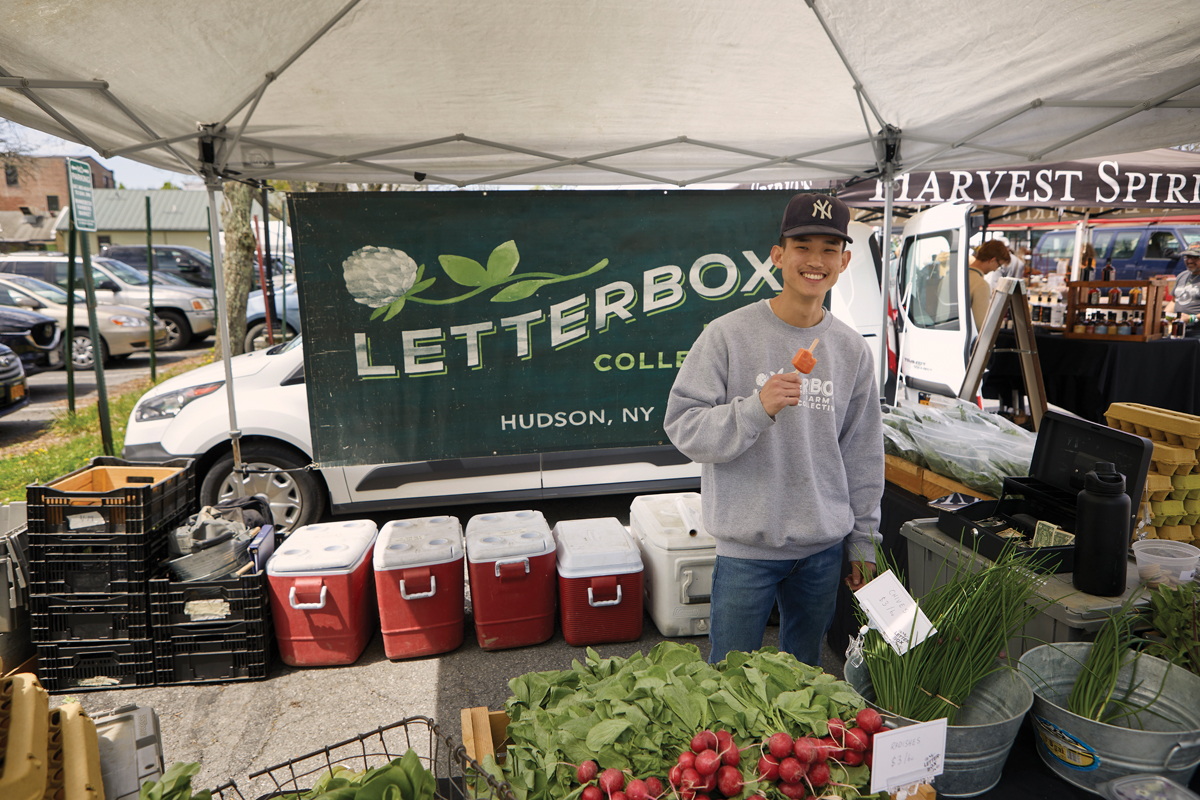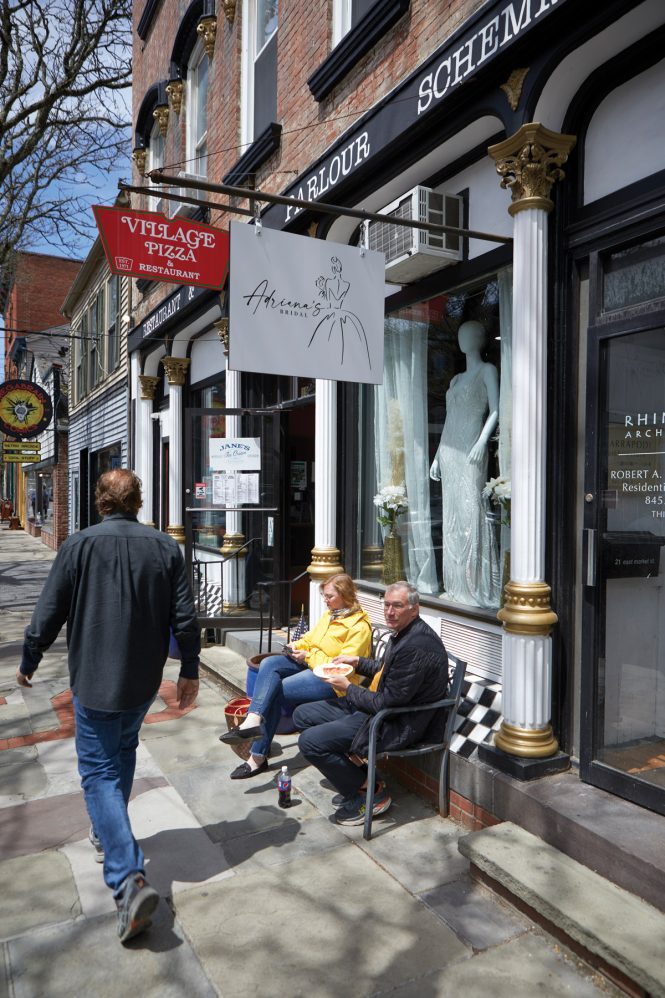Rhinebeck: A Place in Time
By Anne Pyburn Craig | Photos by David McIntyre | Summer 2023 | Community Spotlight
In 1983, the New York Times Weekend section characterized Rhinebeck as “A Village that Time Passed By” and described the quaint tranquility of a place with “no parking meters, no chrome, no fast-food outlets, one traffic light, an inn dating back to 1766 that calls itself the oldest hotel in the United States, and 344 buildings comprising a National Historic District.”
Four decades later, those facts still stand. But don’t mistake tranquility for somnolence. The onetime violet capital of the world is no hothouse flower set apart from civilization’s concerns. If anything, many in Rhinebeck have their eyes on the future.
“We’re doing a lot, and it’s exciting and very satisfying,” says Village Trustee Vanessa Bertozzi, coordinator of Rhinebeck’s Climate Smart Communities Task Force. “Around 200 people came out for our recent Walk to School Day event, which was wonderful. We’ve completed our Natural Resources Inventory in collaboration with the town. We’re in the process of updating our comprehensive plan, which hasn’t been done since 1993; I’m proud to say that I think that we’re gonna be doing a lot that speaks to the future of this place and makes it more climate friendly.”
A pilot project involving 100 households and half a dozen restaurants was used to bolster a grant application, and the village received $300,000 to build a municipal composting facility. While strong opposition from residents who live near the proposed facility has stalled the project, Bertozzi is hopeful that another version will succeed.
And that historic district that the Times referenced may be changing its boundaries, though no one is suggesting anything as heretical as altering its facades. “We’re looking at expanding the footprint and including Oak Street,” says Bertozzi, “which was the Black and Irish working-class neighborhood back in the late 1700s and then through the 1800s. Bill Jeffway, the Dutchess County historian, did an incredible project on that history, and it’s not written into law yet but we’re really excited that it will become part of the district.”
Also exciting: Rhinebeck’s freshest local independent media, including Radio Free Rhinecliff, streaming new shows and locally produced podcasts every Friday from the backroom of the Epicurean grocery store, and the Hudson Valley Pilot, a freshly launched online news source dedicated to up-to-the-minute examination of all things Rhinebeck. “The impetus was conversations like ‘Wow, there was an election and nobody knows who won,’ and the realization that that’s not how it should be,” says Eric Steinman, Pilot editor-in-chief. “It’s also driven by the way independent media and local news sources have been drying up for years, leaving people to try to glean news from social media and get questionable information. So we’re trying to build this old/new model, keeping it very local and centered around personal stories and political stuff, bringing to light what’s really going on. Honestly, it’s been more successful than I even expected it to be at this point—we’re getting lots of donations and sponsorship, and people are really excited.”
Rhinebeckers were apparently less excited when a Moms for Liberty-backed candidate appeared on the 2022 school board ballot, with talk of book bans and such. “There was a good bit of talk, and some fear,” says Steinman. “But he lost by a considerable amount, and this year’s school board election isn’t particularly competitive. So I think we’re in the clear for now.”
The Rhinebeck Scene
Rhinebeck’s food scene is outstanding, with 22 restaurants—two of which opened in the same week last April—ranging from pizza and sandwiches to the French fare at Le Petit Bistro or roasted oysters and Wagyu sirloin at the Willow at Mirbeau Inn and Spa. There’s outstanding falafel at Aba’s, top-notch Indian fare at Cinnamon, and splendid Irish cuisine at Bia. The two newest eateries are Cafe Con Leche, offering authentic Puerto Rican food, and Pretty to Think So, a chic barroom with extensive raw bar offerings and farm-to-table dishes.
Indie retail spots offer up everything from antiques and fine paper goods to toys, books, comics, and skateboarding gear. There are several art galleries, and clothing shops for everyone from kids and country folk to those needing chic executive duds. You’ll find wonderful local artisanal things at Winter Sun & Summer Moon and Periwinkles, interior pieces at Hammertown and House SFW, and fine jewelry at Hummingbird and Zimmer Brothers.

East Market Street is part of the village’s bustling downtown.
The Starr Library has a jam-packed calendar of community offerings; Omega Institute for Holistic Studies has a 108-page catalog of workshops scheduled this year; and Izlind Integrative Health has gathered a collective of 18 advanced practitioners of every sort of wellness-focused modality. There are festivals throughout spring and summer and a bangin’ county fair at the Dutchess County Fairgrounds. And Rhinebeckers are a mere stone’s throw from the eclectic cultural offerings at Bard College’s Fisher Center.
The Rhinebeck Real Estate Market
Rhinebeck realtor and Dutchess County native Rachel Hyman-Rouse says things in Rhinebeck are still high and tight. “Basic starter homes are going for $700,000,” she says. “It’s actually shocking. People think realtors must be immune, but I actually was looking for a house in the village during COVID myself and got beaten in a bidding war. Inventory’s still very low; there are conversations underway about housing affordability, but realistically, it takes two years to build anything at all up here. I’d say that if you want to live here, keep your eyes open and have what you need lined up—including patience.”
At this writing, a three-bedroom raised ranch just outside the village was being offered for $383,000 and a one-bedroom townhouse, also just outside the village, was priced at $495,000. Five miles out of town, a 3,000-square-foot, three-bedroom contemporary with lake rights had just been reduced from $749,000 to $725,000. Within the village, a 1920s gem with stained glass windows, wraparound porch, and 3,800 square feet was on the market for $1,595,000.
